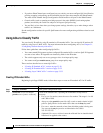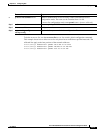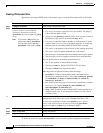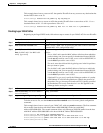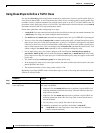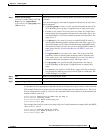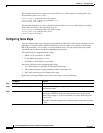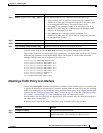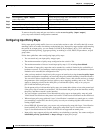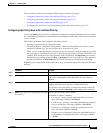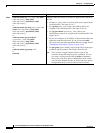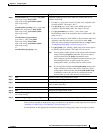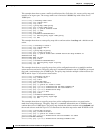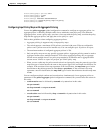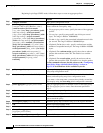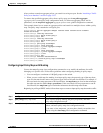
33-38
Cisco ME 3400 Ethernet Access Switch Software Configuration Guide
OL-9639-06
Chapter 33 Configuring QoS
Configuring QoS
To remove the policy map and port association, use the no service-policy {input | output}
policy-map-name interface configuration command.
Configuring Input Policy Maps
Policy maps specify which traffic class to act on and what actions to take. All traffic that fails to meet
matching criteria of a traffic class belongs to the default class. Input policy maps regulate traffic entering
the switch. In an input policy, you can match CoS, DSCP, IP precedence, ACLs, or VLAN IDs and
configure individual policing, aggregate policing, or marking to a CoS, DSCP, IP precedence, or QoS
group value.
Follow these guidelines when configuring input policy maps:
• You can attach only one input policy map per port.
• The maximum number of policy maps configured on the switch is 256.
• The maximum number of classes in each input policy map is 32, including class-default.
• The number of input policy maps that can be attached in a switch is limited by the availability of
hardware resources. If you attempt to attach an input policy map that causes any hardware resource
limitation to be exceeded, the configuration fails.
• After you have attached a single-level policy map to an interface by using the service-policy input
interface configuration command, you can modify the policy without detaching it from the interface.
You can add or delete classification criteria, add or delete classes, add or delete actions, or change
the parameters of the configured actions (policers, rates, mapping, marking, and so on). This also
applies to changing criteria for the child policy of a hierarchical policy map, as in a per-port
per-VLAN hierarchical policy map.
For the parent policy of a hierarchical policy map, you cannot add or delete a class at the parent level
if the policy map is attached to an interface. You must detach the policy from the interface, modify
the policy, and then re-attach it to the interface.
• You can configure a maximum 2-level hierarchical policy map as an input policy map only with
VLAN-based classification at the parent level and no VLAN-based classification at the child level.
• When an input policy map with only Layer 2 classification is attached to a routed port or a switch
port containing a routed SVI, the service policy acts only on switching eligible traffic and not on
routing eligible traffic.
• On an IEEE 802.1Q tunnel port, you can use only an input policy map with Layer 2 classification
based on MAC ACLs to classify traffic. Input policy maps with Layer 3 classification or with
Layer
2 classification based on CoS or VLAN ID are not supported on tunnel ports.
• Input policy maps support policing and marking, not scheduling or queuing. You cannot configure
bandwidth, priority, queue-limit, or shape average in input policy maps.
Step 3
service-policy {input | output}
policy-map-name
Specify the policy-map name and whether it is an input policy
map or an output policy map.
Step 4
end Return to privileged EXEC mode.
Step 5
show policy-map interface [interface-id] Verify your entries.
Step 6
copy running-config startup-config (Optional) Save your entries in the configuration file.
Command Purpose



